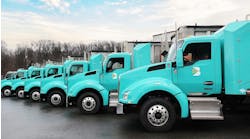Mixed fleets have a lot to consider when it comes to engine oil management. Modern heavy duty vehicles are much different than those that rolled off of the assembly line 10 or more years ago. Engines run hotter, and in many cases, oil drain intervals are much longer.
Something fleets should not take for granted is the engine oil filter.
“First and foremost, it is always recommended to choose a reputable filter company that complies with OE specifications,” said Brian Tucker, director of engineering for Donaldson Engine Liquid Filtration, a provider of engine and industrial air, oil, and liquid filtration solutions.
“Engine changes have ushered in more exacting tolerances and higher pressures to the overall lubrication system,” added Donald Chilton, director of product management at MANN+HUMMEL, a global provider of filtration solutions whose brands include WIX Filters. “This demands higher levels of filtration with respect to micron-level protection and holding capacities. More advanced filter medias are developed and manufactured today than in years past. The important thing to know is that this cannot always be seen by the eye. Rather, the results show in the performance on the road and in the lab.”
Three key filter performance factors
Understanding how to choose the right filter goes beyond just fit and form.
“The key parameters that describe the filter’s functional capabilities must also be considered,” said Chris Reamsnyder, vice president of sales for commercial vehicle at First Brands Group, a global automotive parts company whose brands include Luber-finer filters. “Filtration companies will start this discussion with capacity, efficiency, and restriction.”
Capacity is a measure of how much contaminant the filter can hold. Efficiency helps illustrate how effective the filter is at removing contaminants. The restriction of the filter gauges the resistance to flow.
Reamsnyder said the filter media has a dramatic impact on each of these performance characteristics and should be assessed by certified lab testing.
Cellulose-based media are typically used in standard-grade oil filters for older engines with less demanding requirements. As Reamsnyder points out, a pure cellulose-based media is the most cost-effective solution but may not be a suitable fit for newer engine applications.
Synthetic or glass-based media provide great performance in just about any environment.
“Due to the durability associated with these types of media, they are great for the toughest of applications, such as off-road construction, mining, and agriculture,” Reamsnyder said. “Unfortunately, glass media can be an expensive option.
“Synthetic blends can sometimes be viewed as offering the best of both worlds,” Reamsnyder continued. “With synthetic blends, manufacturers can balance the key strengths of both cellulose and synthetic grades and still provide enhanced performance characteristics. Although costs may vary, most heavy duty engines built today require the level of filtration that these media grades provide.”
Sometimes an oil filter also features unique design characteristics. Fleets should take a step back from the marketing razzle dazzle, though, and come to understand how a given feature is expected to help provide better engine protection.
For instance, patent-pending Spin Flow Technology, as found in the WIX XD oil filter, uses angled fins to start the filtration of heavy particles away from the oil.
“Bigger particles are spun down and trapped, providing an extra layer of protection,” Chilton explained.
Newer formulations and longer drain intervals
Something else fleets should consider is the type of engine oil a given vehicle is using. Depending on whether the vehicle is using a traditional 15W-40 or a newer, lower-viscosity oil, the ideal type of oil filter may vary.
“Many of the newer engine oil formulations are reverse-compatible with older engines,” Donaldson’s Tucker said. “They are also compatible with many of the filters that have been designed to newer OE engine specifications.”
What makes things interesting these days is the choice between a newer CK-4 oil and an FA-4 oil. CK-4 oils are designed to be backwards-compatible, meaning they can be used in older engines. On the other hand, FA-4 oils have limited backwards-compatibility.
“Some OEs are allowing for the use of a lower-viscosity FA-4 oil, which provides fuel economy benefits and extended drain intervals,” Tucker pointed out. “Donaldson’s oil filter technology aligns well with this. Our base oil filters are compatible with both CK-4 and FA-4 oils, but we also offer an upgraded line called Donaldson Blue filters. This is a smart option for a fleet that really wants to push those oil drain intervals.”
Donaldson Blue is designed for increased efficiency and longer life – both of which are paramount to achieving the goal of longer drain intervals without sacrificing protection. Obviously, if the oil is staying in the engine longer, the oil filter has to last just as long.
“With a lower-viscosity oil like an FA-4, you typically get a thinner lubricating film,” Tucker added. “Bumping up the efficiency of the oil filter provides added wear protection in the engine because it captures smaller particles that could cause wear with these oils.”
To make its “upgraded” filter more efficient, Donaldson has focused on the filtration media that is used inside the filter.
“Historically speaking, standard oil filters have used a cellulose media, or perhaps a blend of mostly cellulose media mixed with some synthetic fibers,” Tucker explained. “These filters are typically in the 20- to 30-micron range and have always provided adequate performance at a standard drain interval. On the other hand, our upgraded Donaldson Blue filters have a fully synthetic media pack. This includes smaller fibers that deliver a higher level of contaminant capture and retention, all while delivering lower restriction for maximum oil flow. Now we’re talking about a 15-micron filter.”
Today’s engines that run hotter can also benefit from a higher-efficiency oil filter.
“Our upgraded filter has higher-grade materials that can resist those higher engine temperatures for longer durations,” Tucker pointed out.
Understanding application-driven needs
Sometimes a mixed fleet that services a wide range of vehicle types, makes, models, and model years wants to simplify by inventorying a single engine oil, typically a 15W-40. Tucker said the primary consideration is still the drain interval. If the interval is more along traditional norms of a 15W-40, a fleet may not be compelled to spend the extra money on a higher-efficiency filter.
That said, a fleet must also consider the application a given vehicle is undertaking.
“Applications that run hot or have a heavy duty cycle – such as mining, short haul, and construction vehicles – may require premium materials for internal and external seals as well as anti-drain and relief valves,” First Brands Group’s Reamsnyder explained. “A reputable filter company will ensure that higher-grade materials are properly specified to meet the specific demands of the application.”
MANN+HUMMEL’s Chilton pointed out that there isn’t necessarily a “long-haul” filter on the market. A fleet must look at its own situation, vehicle by vehicle, and determine the level of protection needed on a case by case basis.
“Maintenance schedules determine change rates, so a filter has to last in both short- and long-haul environments,” Chilton said. “We have to engineer filters to do everything regardless of what the truck does. If you are having water issues or short air filter life, there are solutions for each of those issues, plus many more.”
Last-mile vehicles in particular benefit from filters made with high-grade materials due to the large volume of short trips and starts/stops, which can be hard on an engine. On the other hand, long-haul vehicles are much easier on engines. Therefore, Reamsnyder said high-grade filters are not typically a requirement for this application.
Tucker said Donaldson Blue filters have been designed for the most extreme applications, alluding to environments that are hot and humid, frigidly cold, mountainous, and dirty. The work the vehicle is doing also plays a role.
“The environment and duty cycle of the vehicle can definitely impact the cleanliness of the oil,” Tucker said. “That is something you have to pay close attention to when selecting your filter. This is especially true in environments that are dusty and dirty. An upgraded filter will help capture more contaminants and also have enough capacity to withstand a longer drain interval.”
Tucker said that while Donaldson’s upgraded filter is more expensive, the value it provides more than makes up for the added upfront cost.
“By having a reliable filter that allows for an extended drain interval, the fleet is going to see much lower maintenance costs overall,” Tucker said.
For instance, fewer oil filters will be consumed over the course of a year because they last longer. Plus, considerably less technician time will be spent performing oil and filter changes.
The big benefit of a higher-efficiency filter, however, ties to preventive maintenance – with an emphasis on the word “preventive.”
“If you want to go for those extended drain intervals, understand that you will be exposing the engine to larger particles for longer periods of time,” Tucker said. “You could be risking some of the components inside of the engine if you are not using the right filter. Furthermore, with these lower-viscosity oils, an upgraded filter will help capture all of those fine particles that a lower-viscosity oil might be more susceptible to.”




